Quantitative Estimation of Fungicide, Pesticide Residues from Pepper (Piper Nigrum L.) as Obtained in the Selected Area of Kodagu District, Karnataka.
Venkatesh R and Neena Joshi
Department of Food Science and Nutrition, University of Agricultural Sciences, GKVK, Bengaluru-560065 Karnataka, India.
Corresponding Author E-mail: venkateshnaik.chn@gmail.com
DOI : http://dx.doi.org/10.13005/ojc/330159
Kodagu is the one of the major pepper cultivated district in Karnataka state. The present study was carried out in the different villages such as Tuchumaleri, Chikkamandur, Mattur, Nallur, Kunda, Balaji, Kottur, and MallanakereetcofPonnempet, Kodagu district Karnataka. During the pepper cultivation the farmers are used the pesticides in each steps, for high yielding purpose. This study was revealed that to measure the amount of pesticides present in the final product. Aflatoxin is produced by the fungi aspergillusflavus and it having properties of nephrotoxic, teratogenic, carcinogenic, and immunosuppressive. It can be determined by the reliable method like HPLC (column symmetry C-18; 4.6X250 mm) used with detection by florescence (excitation 364 nm, emission 465 nm). Like that the organo phosphors also determined by GC (column summery RTX-5; 30m) the level can be indicated in ppb and ppm respectively.
KEYWORDS:Pepper; Aflotoxin; Organo phosphorous; HPLC; GC
Download this article as:| Copy the following to cite this article: Venkatesh R, Joshi N. Quantitative Estimation of Fungicide, Pesticide Residues from Pepper (Piper Nigrum L.) as Obtained in the Selected Area of Kodagu District, Karnataka. Orient J Chem 2017;33(1). |
| Copy the following to cite this URL: Venkatesh R, Joshi N. Quantitative Estimation of Fungicide, Pesticide Residues from Pepper (Piper Nigrum L.) as Obtained in the Selected Area of Kodagu District, Karnataka. Orient J Chem 2017;33(1). Available from: http://www.orientjchem.org/?p=28365 |
Introduction
Pepper (Piper nigrum L.) belongs to the family Piperaceae, the crop grow well in a temperature range between 25°-40°C and rainfall around 1250 mm. In India, Karnataka, Kerala, Tamilnadu states are play a major role in the production of pepper. As per the 2013-14 report 21,250 tones of black pepper worth Rs. 94,002 lakhs products were exported from India to various countries.
Pepper is one of the important spiceused for flavor, and aroma of food and beverages, is produced from the still-green, unripe drupes of the pepper plant. Peppercontains volatile oil so it makes an important contribution to sensory qualities1
In Indian ayurveda system the pepper are used as a medicine since 5000 years, as a diet and herbal remedies, it is a source of important drugs such as atropine, codeine, digoxin, morphine, quinine and vincristine2.While emphasizing the body, mind and spirit in disease prevention and treatment3.
Black pepper is a king of spices, used for medicinal agent, preservative, and in perfumery4. Its contains major pungent alkaloid Piperine(1-peperoyl piperidine), exhibits5 pharmacological activities like antihypertensive and antiplatelets6,antioxidant, antitumor, anti- asthmatics7, antipyretic, analgesic, anti-inflammatory, anti-diarrheal, antispasmodic, anxiolytic, antidepressants8hepato-protective9,immuno-modulatory, antibacterial, antifungal, anti-thyroids, anti-metastatic, antimutagenic, etc.
Piperine has been found to enhance the therapeutic efficacy of many drugs, vaccines and nutrients by increasing oral bioavailability by inhibiting various metabolizing enzymes10.The consumption of black pepper increases the orocecal transit time.11and also decreased pressure in arteries, it inhibited high K+ pre contractions due to blockade Ca2+ channel12, apart from that it having an anti diarrheal property hence in most of the developing countries local peoples, herbal industries, and herbal practioners formulate the peppercorn for diarrhea for all ages13.
Nerolidol is a natural compound isolated from piper species, having pesticidal activity against various mites. And another compound pipene isolated from volatile oil of peppercorn it is used as an odorant14.
Materials and Methods
Collection of Sample
Kodagu is one of the major pepper cultivated district in Karnataka state hence the pepper (Piper nigrum L) samples are collected from the different villages of ponnempet. The samples were collected in a zip polythene bags.And preserved in deep freezer.
Interview Questionnaires
Questionnaires was contained 4 sections to find out the details like Physical inspection (location, soil type and weather data) general information (type of crop, aware of pesticide effect and recommended dosage) cultivation steps (name of the verity, land preparation, spacing, month of plantation, intercropping, duration and common diseases) pesticide information (name of pesticide used, method of application etc.)
A total of 10 farmers from different villages of ponnempet, kodagu district were interviewed. They are majorly cultivated pepper plant in a distance of 10-15 feet of panniruverity with a support of forest trees or gliricidia plant and coffee is an intercropping in sand mixed and black soil and most of all the farmers not aware of pesticide effect on human health. Some of them were engaged in the application of pesticides for the high yielding purpose, and revealed via interview the generally used pesticides in this district were copper sulphate, bodomixture, trichoderma, copper oxichlorideetc through power/hand spraying for controlling black and yellow wilt diseases.
Chemicals / Materials Used
Acetone, petroleum ether, Dichloro methane. Diethyl ether, Sodiumsulphate, Florosil, sodium chloride, tween 20, Methanol, KBr, conc. Nitric acid, acetonitril, butter paper, flutted filter paper, micro fiber filter paper, IAC(immune affinity column) and HPLC water.
Stock and Working Standard
Stock and working standard of organo phosphorous pesticides of appropriate concentration in acetone (standard from EPA of equivalent). Store the standards under refrigeration. (Shelf life for stock standard is one year and that for working standard is six months)
Analysis of Aflatoxin
Weigh the sample into a blender jar.
Add NaCl into blender jar.
Add 100 ml of 80:20 methanol & HPLC water mix.
Cap blender jar and seal with Parafilm.
Blend at high speed for 1 minute
Then filter it into a beaker through fluted filter paper.
Pipette 10 ml of filtrate into 50 ml graduated cylinder.
If the sample is nutmeg, oregano, or black pepper, add 40 mL of 20%Tween-20 solution to the graduated cylinder. If the sample is not one of the products mentioned, add 40 ml of DI Distilled water to the cylinder. Mix thoroughly.
Filter the contents of the graduated cylinder through a glass fiber filter into a 250 ml beaker. This filtrate will be used for the Aflatest column.
Immuno-Affinity Column Clean-Up
Attach an Aflatest-P column to the pump stand.
Pipette 10 ml of filtrate to the syringe and pass through the IAC column
Once the entire sample has passed through the column, rinse the column with 10 ml of HPLC water. Repeat HPLC water rinse.
Place 20 ml stoppered test tube under the tip of the column and add 1 ml of methanol to the column.
Collect all the methanol eluent in the test tube. And transfer the sample to a sample vial. The sample is now ready for injection to the HPLC.15
Analysis of Organo Phosphorous
Rinse thoroughly all the glass wares first with acetone and then with petroleum ether before starting the analysis
Always do a reagent blank along with sample
Sample preparation
whole spice:-The entire sample is reduced in six by mixing and quartering and a subsample of 100g taken for crushing/blending. A representative sample of 20g (in duplicate) is taken for analysis.
Crushed/ground spices
The entire sample is reduced in size by mixing and quartering and a subsample of 100g is taken. From this a representative sample of 20g is taken for analysis.
Extraction
Transfer the above weighed sample to a 500 ml stoppered conical flask
Add freshly prepared acetone-water mixture
Keep on the laboratory shaker for 1hour with occasional shaking
Filter through whatman No.1 filter paper in a bucher funnel, using vacuum pump
Shake well and transfer 100 ml of filtrate to the 250ml separating funnel
To this add 50ml petroleum ether first and then 50ml methylene dichloride
Shake vigorously for about 2 minutes and then allow to stand for the separation of layer
After clear separation layer, transfer the lower layer to another 250 ml separating funnel.
To this add 100 ml MDC. Shake and allow to stand.
Collect the upper layer of step-7 to a beaker after passing through a funnel containing anhydrous sodium sulphate which is supported by glass wool pre wetted with petroleum ether
After the separation of layer, collect the lower layer of the 2nd separating funnel to the same beaker by passing through the same funnel containing sodium sulphate
Transfer this solution quantitatively to rotary evaporator flask/water bath and concentrate to minimum volume. This is ready for clean up.
Florosil Cleanup for Organo Phosphorous
Place activated florosil (about 4″) in the column; add about 0.5″ sodium sulphate pre wet column with 50 ml petroleum ether.
Transfer the concentrate to sintered column using 8ml HPLC grade acetone, and rinse walls of chromatographic tube with additional small portion of acetone. Drain with 100 ml of petroleum ether and collect and collect it in a 500 ml beaker.
Elute column at about 5ml/minute with 200ml diethyl ether-petroleum ether (50:50). Collect the eluant in the beaker containing petroleum ether in step-2
This elute is ready for concentration step for organo phosphorous pesticides by roatary evaporator/water bath.
Concentrate the above extract to minimum volume.
Concentrate the extract using a water bath/ K. D Evaporator/ Rotary evaporator
Rinse the content with acetone and transfer to a graduated stopped test tube
Make up to 4ml with acetone. This is ready for GC analysis16.
Calculation
Aflatoxin

Organo Phosphorous

Table 1: Aflatoxin Standard
|
Peak |
Name |
Ret. Time |
Area |
Area% |
Conc. |
|
1 |
G2 |
7.067 |
264859 |
11.573 |
20.000 |
|
2 |
G1 |
8.114 |
660603 |
28.866 |
80.000 |
|
3 |
B2 |
8.916 |
445142 |
19.451 |
20.000 |
|
4 |
B1 |
10.402 |
917926 |
40.110 |
80.000 |
| Total |
2288527 |
100.000 |
|
Table 2: Organo phosphorous Standard
| Peak | Ret. Time | Name | Area | Height | Conc. | Units |
| 1 | 2.267 | Dichlorovos | 9179844 | 1568984 | 2000.00 | pG |
| 2 | 3.235 | Acephate | 1816787 | 389424 | 4000.00 | pG |
| 3 | 4.772 | Omethoate | 3891511 | 756206 | 4000.00 | pG |
| 4 | 5.519 | Monocrotofos | 141960 | 44365 | 4000.00 | pG |
| 5 | 5.670 | Phorate | 10316861 | 1888548 | 2000.00 | pG |
| 6 | 6.310 | Dimethoate | 2394844 | 611262 | 2000.00 | pG |
| 7 | 6.870 | Diazinon | 5129908 | 1414095 | 2000.00 | pG |
| 8 | 7.083 | Disulfoton | 3150731 | 900220 | 2000.00 | pG |
| 9 | 7.253 | Etrimphos | 2821356 | 850826 | 2000.00 | pG |
| 10 | 8.133 | Parathion methyl | 525406 | 1626396 | 2000.00 | pG |
| 11 | 8.720 | Pirimiphos methyl | 9816919 | 1781049 | 2000.00 | pG |
| 12 | 8.882 | Malalthion | 2870442 | 938102 | 2000.00 | pG |
| 13 | 10.128 | Quinolphos | 5806111 | 2071751 | 2000.00 | pG |
| 14 | 11.096 | Profenophos | 3184702 | 1170602 | 2000.00 | pG |
| 15 | 12.077 | Ethion | 749567 | 284785 | 1000.00 | pG |
| 16 | 12.397 | Triazophos | 4486193 | 1655339 | 2000.00 | pG |
| 17 | 13.804 | Phosmet | 1026677 | 389577 | 2000.00 | pG |
| 18 | 14.524 | Phosalone | 3009899 | 1017151 | 2000.00 | pG |
| 19 | 15.313 | Azinphos ethyl | 2254325 | 691752 | 2000.00 | pG |
| Total | 77302702 | 20050434 |
Table 3: Amount of Pesticides present in sample no. 3
| Sl.no | Compound Name | Results in ppm | EU Limits in ppm |
| 1. |
Diazinon |
0.01 |
0.1 |
| 2 |
Malathion |
0.01 |
0.02 |
| 3 |
Quinophos |
0.01 |
0.1 |
| 4 |
Profenophos |
0.02 |
0.07 |
| 5 |
Ethion |
0.02 |
5 |
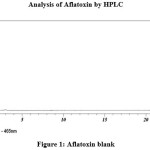 |
Figure 1: Aflatoxin blank |
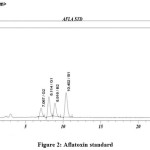 |
Figure 2:Aflatoxin standard
|
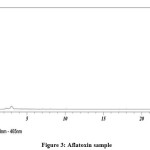 |
Figure 3: Aflatoxin sample
|
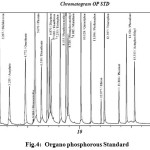 |
Figure 4: Organo phosphorous Standard |
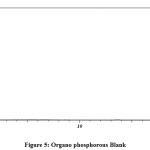 |
Figure 5: Organo phosphorous Blank |
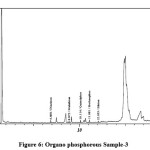 |
Figure 6: Organo phosphorous Sample-3 |
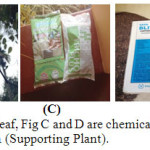 |
Figure 7: A and B are disease effected leaf, Fig C and D are chemicals used during the cultivation of pepper plant and Fig.E Gliricidia (Supporting Plant). |
Results and Discussion
Kodagu is one of the major pepper cultivated district of the state Karnataka so that ten samples were collected from different villages of ponnempet of the above district. For the high yield purpose some of the farmers are used pesticides such as copper sulphate,bodomixture, trichoderma, copper oxichlorideetc., through power/hand spraying for controlling black and yellow wilt diseases17.This study shows the quantitative estimation of fungicide, pesticide residual content in the collected pepper samples by ASTA method using HPLC and GC. All the analysis of ten samples the result shows the absence of aflotoxins (G2 G1 and B2, B1). In the pesticides (Organo phosphorous) totally analyzed 19 chemical compounds from each collected sample in that Diazinon, Malathion, Quinophos, Profenophos and ethion are present in sample number three that was collected from the mattur village. But it also in acceptable range (within EU limits) 1.e. 0.01, 0.01, 0.01, 0.02 and 0.02ppm respectively.
Conclusion
As per the survey and quantitative estimation of fungicide(Aflotoxin), pesticide(Organo phosphorous) analysis results shows the samples collected from the different villages of Ponnempet of Kodagu district Karnataka was within the EU limits hence it was free from fungicide, pesticide content.
Acknowledgement
I thank the University Grants Commission (UGC) for providing financial support for this research work. I also wish to thank Department of Food Science and Nutrition, University of Agricultural Sciences,GKVK, Bangaluru for laboratory facility.
References
- FSSAI, manual methods of analysis of foods spices and condimentslab manual. 2012,10
- Tyler, V.E. J. Public Health Nutrition.2000,3, 447–452
CrossRef - Morgan, K. Medicine of the Gods Basic Principles of Ayurvedic Medicine http://www.compulink.co.uk.mandrake/ayurveda.htm, 2002
- Devasahayam, S.; JohnZacharaiah, T.; Jayashree, E.; Kandiannan, K.; Prasath, D.; Santhosh, J.; Sasikumar, B.; Srinivasan, V.; Suseelabhai, R. ICAR Indian institute of spice research Black pepper Extension pamphlet,2015,1-27
- Taqvi, S. I.; Shah, A. J.; Gilani, A. H. J. Cardiovasc.Pharmacol.2008, 52, 452-58
CrossRef - Manoharan, S.; Balakrishnan, S.; Menon, V.; Alias, L.; Reena, A. J. Singapore Med.2009,50,139-146
- Parganiha, R.; Verma, S.; Chandrakar, S.; Pal, S.; Sawarkar, H. A.; Kashyap, P. J. Inter Herbal Drug Res.2011, 1, 15-18
- Li, S.; Wang, C.; Wang, M.; Li, W.; Matsumoto, K. J. Life Sci. 2007,80, 1373-1381
CrossRef - Matsuda, H.; Ninomiya, K.; Morikawa, T.; Yasuda, D.; Yamaguchi, I. J. PubMed. Bioorg. Med .Chem.2008, 18, 2038-2042
CrossRef - Johnson, J.J.; Nihal, M.; Siddiqui, I. A.; Scarlett, C. O.; Bailey H. H. J. PubMed Mol.Nutr.Food .Res.2011, 55, 1169-1176
CrossRef
- Chatterjee, S.; Niaz, Z.; Gautam, S.; Adhikari, S.; Variyar, P. S.; Sharma, A. J. Food Chem.2007,101, 515-523
CrossRef - Park, B. S.; Son, D. J.; Park, Y. H.; Kim, T. W.; Lee, S. E. J.Phy.med.2007, 14, 853-855
- Singh, A.; Duggal, S. J. Inter.Pharma. Sci. Nano.tech.2009, 2, 615-620
- Jayalekshmy, A.; Menon, A. N.; Padmakumari, K. P. J. Essential. Oil. Res.2003, 15, 155-157
CrossRef - FDA, Office of the Asso. Com. for Leg. Affairs, off. Agen. Res. to OTA draf rep.2008, 29
- AOAC International official method. Eur. Comm. news not.03/99, PAM 3(1) Sec 302 16(1), 985.
- Ahamedbavappa, K.V.; Ravindra, P.N.; Muliyar, M. K. Pamphlet. 1986, 7, 1-14.

This work is licensed under a Creative Commons Attribution 4.0 International License.









